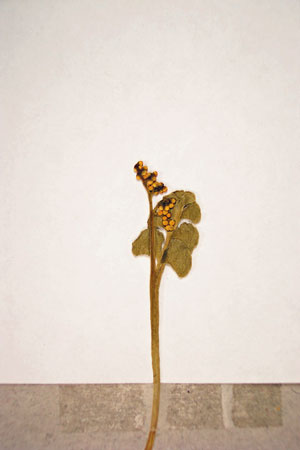DACF Home → Bureaus & Programs → Maine Natural Areas Program → Communities, Plants, and Animals → Rare Plants → Botrychium lunaria

Botrychium lunaria (L.) Sw.
Moonwort
- State Rank: S1
- Global Rank: G5
- State Status: Endangered
Habitat: Open turfy, gravelly or ledgy slopes, shores and meadows, chiefly calcareous. [Old field/roadside (non-forested, wetland or upland); Rocky coastal (non-forested, upland)]
Range: Greenland to Alaska, south to parts of the extreme northern United States.
Aids to Identification: Like most members of the genus Botrychium (Grape-ferns), B. lunaria is distinguished both by its succulent texture and by the fertile frond, which appears above the sterile frond and consists of a cluster of golden-brown globular sporangia (hence the name grape-fern). It differs from the other succulent Botrychium species in having the sterile blade only once-pinnate (divided), with the segments distinctly fan-like (lunate) in shape. The entire plant usually stands less than 8 cm high.
Ecological characteristics: Moonwort is a circumboreal species which is sporadic through much of its range. Because it is so rare in New England, little is known about its ecological relationships here. It is a calciphile (growing in areas of higher available calcium) and seems to prefer moderate light rather than deep shade. At one known Maine station, the necessary calcium is apparently derived not from a limestone bedrock, but rather from the mussel and clam shells which have been deposited on the shore.
Phenology: A fern (perennial): fertile segment and sporangia appear in July in Maine.
Family: Ophioglossaceae
Synonyms: Botrychium lunaria (L.) Sw. var onondagense (Underwood) House; Botrychium onondagense Underwood; Osmunda lunaria L.
Known Distribution in Maine: This rare plant has been documented from a total of 6 town(s) in the following county(ies): Aroostook, Franklin, Hancock, Knox, Washington.
Reason(s) for rarity: At southern limit of range; rare throughout much of range.
Conservation considerations: Known populations are small, and subject to the vagaries of small populations like random fluctuations or localized disturbance events. At least one has not been recently relocated even with extensive searching in exactly the same spot.
For more information, see the Native Plant Trust's Conservation Plan for Botrychium lunaria.